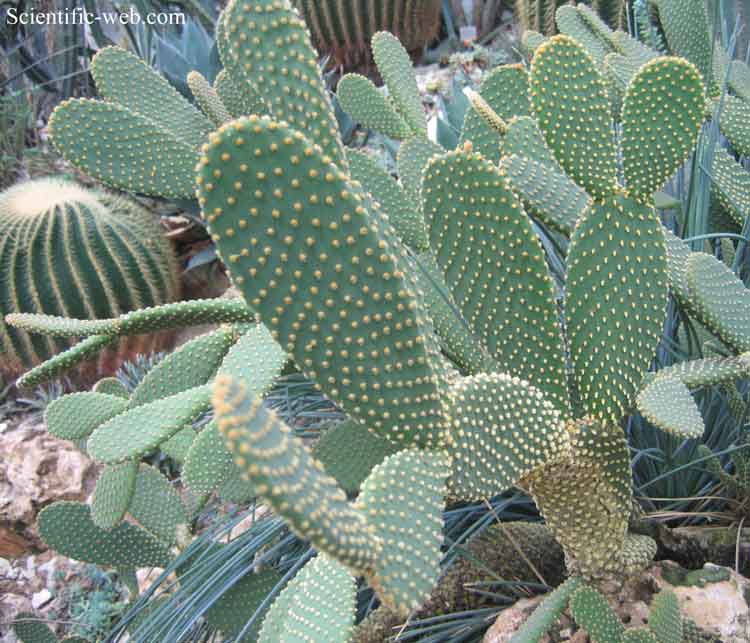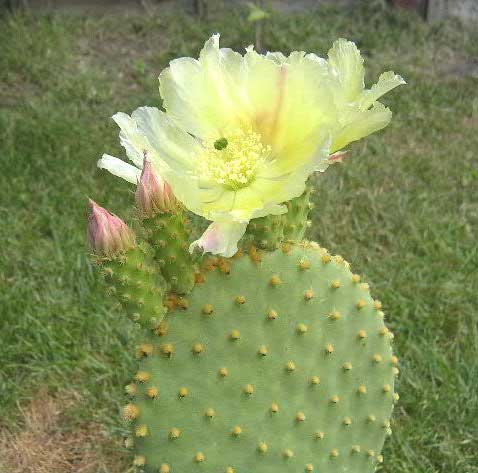
Opuntia microdasys, Photo: Michael Lahanas
Classification System: APG IV
Superregnum: Eukaryota
Regnum: Plantae
Cladus: Angiosperms
Cladus: Eudicots
Cladus: Core eudicots
Ordo: Caryophyllales
Familia: Cactaceae
Subfamilia: Opuntioideae
Tribus: Opuntieae
Genus: Opuntia
Series: O. ser. Pubescentes
Species: Opuntia microdasys
Name
Opuntia microdasys (Lehm.) Pfeiff. (1837)
Hybrids
O. × andersonii – O. × carstenii
Synonyms
Cactus microdasys Lehm., Index Sem. (Hamburg): 16. 1827 syn. sec. Parfitt & Gibson 2003
Opuntia microdasys subsp. microdasys syn. sec. ???
Opuntia pulvinata DC. in Mém. Mus. Hist. Nat. 17: 119. 1828 syn. sec. Britton & Rose 1919
Opuntia microdasys var. minor Salm-Dyck, Hort. Dyck.: 186. 1834 syn. sec. Tropicos
Opuntia microdasys f. minor (Salm-Dyck) Schelle, Handb. Kakteenkult.: 47. 1907 syn. sec. Kew WCVP (2019)
Opuntia microdasys var. laevior Salm-Dyck, Cact. Hort. Dyck., ed. 1849: 241. 1850 syn. sec. Tropicos
Opuntia macrocalyx Griffiths in Rep. (Annual) Missouri Bot. Gard. 19: 268–269, pl. 28. 1908 syn. sec. Tropicos
Opuntia lubrica Griffiths in Rep. (Annual) Missouri Bot. Gard. 21: 169, t. 23. 1910 syn. sec. Tropicos
Opuntia herrfeldtii Kupper in Monatsschr. Kakteenk.: 212. 1930 syn. sec. Tropicos
Opuntia microdasys var. pallida Borg, Cacti, ed. 2: 83. 1951 syn. sec. Tropicos
Opuntia microdasys var. albispina Fobe & Backeb., Descr. Cact. Nov. 1: 10. 1957 ["1956"] syn. sec. Kew WCVP (2019)
Opuntia microdasys subvar. albiflora Backeb., Cactaceae 6: 3623. 1962 syn. sec. Kew WCVP (2019)
Distribution
Native distribution areas:
Continental: Northern America
Regional: Mexico
Mexico Gulf, Mexico Northeast, Mexico Northwest, Mexico Southwest
Introduced into:
Algeria, Arizona, Canary Is., Cape Provinces, France, Free State, Greece, Italy, KwaZulu-Natal, New South Wales, North Caucasus, Northern Provinces, Portugal, Queensland, South Australia, Spain, Tunisia, Victoria, Western Australia
References: Brummitt, R.K. 2001. TDWG – World Geographical Scheme for Recording Plant Distributions, 2nd Edition

Opuntia microdasys (*)
References
Primary references
Pfeiffer, L.K.G. 1837: Enumeratio Diagnostica Cactearum hucusque Cognitarum< 154.
Additional references
Korotkova, N., Aquino, D., Arias, S., Eggli, U., Franck, A. , Gómez-Hinostrosa, C., Guerrero, P.C., Hernández, H.M., Kohlbecker, A., Köhler, M., Luther, K., Majure, L.C., Müller, A., Metzing, D., Nyffeler, R., Sánchez, D., Schlumpberger, B. & Berendsohn, W.G. 2021. Cactaceae at Caryophyllales. org–a dynamic online species-level taxonomic backbone for the family. Willdenowia 51(2): 251–270. DOI: 10.3372/wi.51.51208 Open access Reference page.
Links
Korotkova, N. et al. 2022. Opuntia microdasys in Cactaceae at Caryophyllales.org. A global synthesis of species diversity in the angiosperm order Caryophyllales. Published on the internet. Accessed: 2022 Jan 14. Reference page.
Govaerts, R. et al. 2022. Opuntia microdasys in Kew Science Plants of the World online. The Board of Trustees of the Royal Botanic Gardens, Kew. Published on the internet. Accessed: 2022 Jan 14. Reference page.
International Plant Names Index. 2022. Opuntia microdasys. Published online. Accessed: Jan 14 2022.
Tropicos.org 2022. Opuntia microdasys. Missouri Botanical Garden. Published on the internet. Accessed: 2022 Jan 14.
USDA, ARS, Germplasm Resources Information Network. Jan 14 in the Germplasm Resources Information Network (GRIN), U.S. Department of Agriculture Agricultural Research Service. Accessed: 2022.
Vernacular names
English: Bunny Ears Cactus, Bunny Cactus, Polka-dot Cactus, Rabbit Ears Cactus, Golden Opuntia
فارسی: تافتونی
suomi: Jänönopuntia
한국어: 금오모자
polski: Opuncja Drobnokolczasta
svenska: Guldopuntia
Opuntia microdasys (angel's-wings, bunny ears cactus, bunny cactus or polka-dot cactus) is a species of flowering plant in the cactus family Cactaceae, native and endemic to central and northern Mexico.[1]
Description
Opuntia microdasys forms a dense shrub 40–60 cm tall, occasionally more, composed of pad-like stems 6–15 cm long and 4–12 cm broad.
Instead of spines it has numerous white or yellow glochids 2–3 mm long in dense clusters. They are barbed and thinner than the finest human hairs, detaching in large numbers upon the slightest touch. If not removed they will cause considerable skin irritation so the plants must be treated with caution.[1]
The Latin specific epithet microdasys means “small and hairy”.[2]
The yellow flowers appear only rarely. Despite this, it is a very popular cactus in cultivation, partly because of the young plant’s comical resemblance to a rabbit’s head. It has gained the Royal Horticultural Society’s Award of Garden Merit.[3][4]
Distribution
Native to Mexico, naturalised in Kenya, Malawi, and Tanzania.[5] One reason for the success of O. microdasys in desert habitats - at home and as an introduction - is its efficient fog collection ability. The spines and hairs have the perfect structure and microstructure to capture and channel fog.[6]
Related species
The very closely related Opuntia rufida differs in having reddish-brown glochids. It occurs further north in northern Mexico, and into western Texas. Some botanists treat the two as a single species.
References
"Opuntia microdasys". Encyclopedia of Life. Retrieved 14 April 2018.
Harrison, Lorraine (2012). RHS Latin for Gardeners. United Kingdom: Mitchell Beazley. ISBN 978-1845337315.
"RHS Plantfinder - Opuntia microdasys". Retrieved 14 April 2018.
"AGM Plants - Ornamental" (PDF). Royal Horticultural Society. July 2017. p. 70. Retrieved 14 April 2018.
"Opuntia microdasys (angel's wings)". Invasive Species Compendium (ISC). CABI (Centre for Agriculture and Bioscience International). 2019-11-19. Retrieved 2021-03-25.
Ju, Jie; Bai, Hao; Zheng, Yongmei; Zhao, Tianyi; Fang, Ruochen; Jiang, Lei (2012). "A multi-structural and multi-functional integrated fog collection system in cactus". Nature Communications. Nature Research. 3 (1): 1-6. doi:10.1038/ncomms2253. ISSN 2041-1723.
Retrieved from "http://en.wikipedia.org/"
All text is available under the terms of the GNU Free Documentation License

